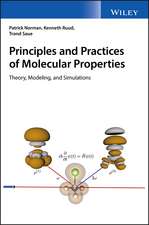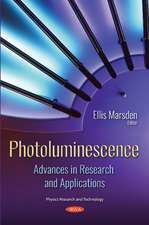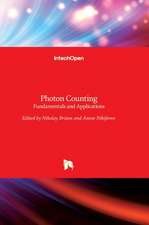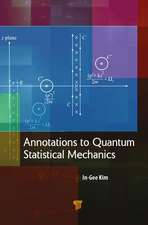DNA Origami: Structures, Technology, and Applicati ons
Autor M Endoen Limba Engleză Hardback – 9 mai 2022
Preț: 1175.25 lei
Preț vechi: 1291.49 lei
-9% Nou
Puncte Express: 1763
Preț estimativ în valută:
224.88€ • 235.43$ • 186.08£
224.88€ • 235.43$ • 186.08£
Carte tipărită la comandă
Livrare economică 05-19 aprilie
Preluare comenzi: 021 569.72.76
Specificații
ISBN-13: 9781119682547
ISBN-10: 1119682541
Pagini: 432
Dimensiuni: 178 x 254 x 24 mm
Greutate: 0.97 kg
Editura: Wiley
Locul publicării:Hoboken, United States
ISBN-10: 1119682541
Pagini: 432
Dimensiuni: 178 x 254 x 24 mm
Greutate: 0.97 kg
Editura: Wiley
Locul publicării:Hoboken, United States
Cuprins
List of Contributors xiii
Preface xvii
1 DNA Origami Technology: Achievements in the Initial 10 Years 1
Masayuki Endo
1.1 Introduction 1
1.1.1 DNA Nanotechnology Before the Emergence of DNA Origami 3
1.2 Two- Dimensional DNA Origami 3
1.3 Programmed Arrangement of Multiple DNA Origami Components 6
1.4 Three- Dimensional DNA Origami Structures 9
1.5 Modification and Functionalization of 2D DNA Origami Structures 11
1.5.1 Selective Placement of Functional Nanomaterials 11
1.5.2 Selective Placement of Functional Molecules and Proteins via Ligands 13
1.5.3 Distance- Controlled Enzyme Reactions and Photoreactions 13
1.6 Single- Molecule Detection and Sensing using DNA Origami Structures 14
1.6.1 Single- Molecule RNA Detection 14
1.6.2 Single- Molecule Detection of Chemical Reactions 14
1.6.3 Single- Molecule Detection using Mechanical DNA Origami 14
1.6.4 Single- Molecule Sensing using Mechanical DNA Origami 14
1.7 Application to Single Biomolecule AFM Imaging 16
1.7.1 High- Speed AFM- Based Observation of Biomolecules 16
1.7.2 Visualization of DNA Structural Changes in the DNA Nanospace 18
1.7.3 Visualization of the Reaction Events of Enzymes and Proteins in the DNA Nanospace 18
1.8 Single- Molecule Fluorescence Studies 19
1.8.1 Nanoscopic Ruler for Single- Molecule Imaging 19
1.8.2 Kinetics of Binding and Unbinding Events and DNA- PAINT 21
1.8.3 DNA Barcode Imaged by DNA- PAINT 21
1.9 DNA Molecular Machines 22
1.9.1 DNA Assembly Line Constructed on the DNA Origami 22
1.9.2 DNA Spider System Constructed on the DNA Origami 22
1.9.3 DNA Motor System Constructed on the DNA Origami 24
1.10 Selective Incorporation of Nanomaterials and the Applications 24
1.10.1 DNA Origami Plasmonic Structure with Chirality 24
1.10.2 Surface- Enhanced Fluorescence by Gold Nanoparticles and DNA Origami Structure 26
1.10.3 Placement of DNA Origami onto a Fabricated Solid Surface 26
1.11 Dynamic DNA Origami Structures Responsive to External Stimuli 27
1.11.1 DNA Origami Structures Responsive to External Stimuli 27
1.11.2 Stimuli- Responsive DNA Origami Plasmonic Structures 27
1.11.3 Photo- Controlled DNA Origami Plasmonic Structures 27
1.12 Conjugation of DNA Origami to Lipid 29
1.12.1 DNA Origami Channel with Gating 29
1.12.2 DNA Origami Templated Synthesis of Liposomes 29
1.13 DNA Origami for Biological Applications 29
1.13.1 Introduction of DNA Origami into Cells and Functional Expression 29
1.13.2 Drug Release Using the Properties Characteristic for DNA Origami 31
1.13.3 DNA Origami Structures Coated with Lipids and Polymers 32
1.13.4 Nanorobot with Dynamic Mechanism 32
1.13.5 Nanorobot Targeting Tumor In Vivo 32
1.14 Conclusions 33
References 34
2 Wireframe DNA Origami and Its Application as Tools for Molecular Force Generation 41
Marco Lolaico and Björn Högberg
2.1 Introduction 41
2.2 Pre- Origami Wireframe DNA Nanostructures 42
2.3 Hierarchical DNA Origami Wireframe 43
2.4 Entire DNA Origami Design 45
2.5 DNA Origami Wireframe as Tools for Molecular Force Application 50
2.5.1 Introduction 50
2.5.2 Results and Discussion 51
2.6 Conclusions 54
2.6.1 Materials and Methods 54
References 55
3 Capturing Structural Switching and Self- Assembly Events Using High- Speed Atomic Force Microscopy 59
Yuki Suzuki
3.1 Introduction 59
3.2 DNA Origami Nanomachines 60
3.3 Ion- Responsive Mechanical DNA Origami Devices 60
3.4 Photoresponsive Devices 62
3.5 Two- Dimensional Self- Assembly Processes 64
3.6 Sequential Self- Assembly 66
3.7 Photostimulated Assembly and Disassembly 67
3.8 Conclusions and Perspectives 69
References 69
4 Advancement of Computer- Aided Design Software and Simulation Tools for Nucleic Acid Nanostructures and DNA Origami 75
Ibuki Kawamata
4.1 Introduction 75
4.2 General- Purpose Software 76
4.3 Software for Designing Small DNA Nanostructures 78
4.4 Software for Designing DNA Origami 81
4.5 Software for Designing RNA Nanostructures 84
4.6 Software for Designing Base Sequence 84
4.7 Software for Simulating Nucleic Acid Nanostructures 85
4.8 Summary and Future Perspective 86
References 87
5 Dynamic and Mechanical Applications of DNA Nanostructures in Biophysics 101
Melika Shahhosseini, Anjelica Kucinic, Peter Beshay, Wolfgang Pfeifer, and Carlos Castro
5.1 Introduction 101
5.1.1 What Makes DNA a Good Material for Dynamic Applications 101
5.1.2 Rupture Forces 103
5.2 Applications 105
5.2.1 Force Spectroscopy 105
5.2.1.1 Utilizing the Stiffness of DNA for Force Spectroscopy 105
5.2.1.2 Applications that Utilize Rupture Forces 107
5.2.2 DNA Devices that Probe and Control DNA-DNA Interactions 108
5.2.2.1 Detection 108
5.2.2.2 Modulation 111
5.2.3 DNA Devices that Respond to Biomolecules 111
5.2.4 DNA Devices to Study Biological Molecular Motors 116
5.2.5 DNA Walkers 116
5.2.6 DNA Computing 119
5.3 Tools for Quantifying DNA Devices and their Functions 120
5.4 Modeling and Analysis 123
5.5 Conclusion 124
References 124
6 Plasmonic Nanostructures Assembled by DNA Origami 135
Sergio Kogikoski, Jr, Anushree Dutta, and Ilko Bald
6.1 Introduction 135
6.2 Optical Properties of the DNA Origami- Based Plasmonic Nanostructures 135
6.3 Nanoparticle Functionalization with DNA 138
6.4 DNA Origami- Based Plasmonic Assemblies 140
6.5 Surface- Enhanced Raman Scattering (SERS) and Other Plasmonic Effects 143
6.6 Conclusion 152
Acknowledgments 152
References 152
7 Assembly of Nanoparticle Superlattices Using DNA Origami as a Template 155
Sofia Julin, Petteri Piskunen, Mauri A. Kostiainen, and Veikko Linko
7.1 Introduction 155
7.2 Gold Nanoparticles 156
7.2.1 Oligonucleotide- Modified AuNPs 156
7.2.2 Cationic AuNPs 158
7.3 Formation of DNA Origami- Assisted Superlattices 158
7.3.1 Superlattices Formed by Oligonucleotide- Functionalized AuNPs 159
7.3.2 Superlattice Formed by Cationic AuNPs 160
7.4 Characterization of Assemblies 160
7.4.1 Electron Microscopy 161
7.4.2 Small- Angle X- ray Scattering 161
7.5 Conclusions and Future Perspectives 162
Acknowledgments 164
References 164
8 Mechanics of DNA Origami Nanoassemblies 167
Deepak Karna, Jiahao Ji, and Hanbin Mao
8.1 Introduction 167
8.2 Analytical Tools to Investigate Mechanical Properties of Nanoassemblies 168
8.2.1 Optical Tweezers 168
8.2.2 Magnetic Tweezers 169
8.2.3 Atomic Force Microscopy (AFM) 169
8.3 Mechanical Strength of DNA Origami Structures 171
8.4 Applications of Origami Nanostructures by Exploiting their Mechanical Strength 173
8.5 Mechanochemical Properties of DNA Origami 175
8.6 Conclusions 177
References 177
9 3D DNA Origami as Single- Molecule Biophysical Tools for Dissecting Molecular Motor Functions 181
Mitsuhiro Iwaki
9.1 Introduction 181
9.2 DNA Origami Nanospring 181
9.2.1 Design of DNA Origami Nanospring 181
9.2.2 Nanospring Mechanical Properties 182
9.2.3 Application to a Myosin VI Processive Motor 183
9.3 DNA Origami Thick Filament Mimicking Muscle Structure 187
9.3.1 Mystery of Muscle Contraction 187
9.3.2 Design of a DNA Origami- Based Thick Filament 188
9.3.3 High- speed AFM Observation of Force Generation by Myosin 189
9.3.4 High- Speed Darkfield Imaging of Force Generation by Myosin 189
9.4 Perspective 193
References 193
10 Switchable DNA Origami Nanostructures and Their Applications 197
Jianbang Wang, Michael P. O'Hagan, Verena Wulf, and Itamar Willner
10.1 Introduction 197
10.2 Switchable Machines Constructed from DNA Origami Scaffolds 198
10.2.1 Chemical Triggers for Origami Scaffolds 198
10.2.1.1 Triggering Origami Devices with Strand Displacement Reactions 198
10.2.1.2 Triggering Origami with Ion Concentration 200
10.2.1.3 Triggering Origami with Molecular Species 202
10.2.2 Physical Triggers for Origami Scaffolds 204
10.2.2.1 Triggering Origami with Temperature 204
10.2.2.2 Triggering Origami with Electric Fields 206
10.2.2.3 Triggering Origami with Magnetic Fields 206
10.2.2.4 Triggering Origami with Light 208
10.3 DNA Origami Scaffolds for Defined Mechanical Operations 210
10.3.1 Origami Scaffolds that Dictate the Motility of Elements 212
10.3.2 Engineering Mechanical Functions of Origami Tiles 218
10.4 Switchable Interconnected 2D Origami Assemblies 218
10.5 Dynamic Triggered Switching of Origami for Controlled Release 223
10.6 Switchable Plasmonic Phenomena with DNA Origami Scaffolds 227
10.7 Origami- Guided Organization of Nanoparticles and Proteins 234
10.8 Conclusions and Perspectives 238
References 239
11 The Effect of DNA Boundaries on Enzymatic Reactions 241
Richard Kosinski and Barbara Saccà
11.1 Introduction 241
11.2 DNA- Scaffolded Single Enzymes 242
11.3 DNA- Scaffolded Enzyme Cascades 247
11.4 On the Proximity Model and Other Hypotheses 250
11.5 Conclusions 254
Acknowledgments 256
References 256
12 The Methods to Assemble Functional Proteins on DNA Scaffold and their Applications 261
Eiji Nakata, Shiwei Zhang, Huyen Dinh, Peng Lin, and Takashi Morii
12.1 Introduction 261
12.2 Overview of the Methods for Arranging Proteins on DNA Scaffolds 262
12.2.1 Reversible Conjugation between Protein and DNA 263
12.2.1.1 Biotin- Avidin 264
12.2.1.2 Antibody- Antigen 264
12.2.1.3 Ni- NTA- Hexahistidine 266
12.2.1.4 Aptamers 266
12.2.1.5 Apo- Protein Reconstitution by the Prosthetic Group 266
12.2.2 Irreversible Conjugation between Protein and DNA 266
12.2.2.1 Chemical Crosslinking of Protein and DNA via Cross- Linker 267
12.2.2.2 Crosslinking of Genetically Fused Protein with Chemically Modified DNA 267
12.2.2.3 Covalent Conjugation of Genetically Modified Proteins to Unmodified DNA 269
12.2.2.4 Applications of the Enzyme Assembled DNA Scaffolds 269
12.3 DNA- Binding Adaptor for Assembling Proteins on DNA Scaffold and its Application 270
12.3.1 DNA- Binding Adaptor for Reversible Assembly of Proteins via Noncovalent Interactions 270
12.3.2 Modular Adaptors for Covalent Conjugation of Genetically Modified Proteins to Chemically Modified DNA 272
12.3.3 Application of DNA- Binding Adaptors for Assembling Proteins on DNA Scaffolds 275
12.3.3.1 Assembling Protein of Interest on DNA Scaffold in Cell 275
12.3.3.2 Enzymatic Reaction System on a DNA Scaffold 275
12.4 Summary 278
References 278
13 DNA Origami for Synthetic Biology: An Integrated Gene Logic- Chip 281
Hisashi Tadakuma
13.1 Introduction 281
13.2 Biomolecule Integration on DNA Nanostructure 281
13.2.1 Nature Uses "Reaction Field" to Overcome the Cross- Talk Problem 281
13.2.2 Synthetic Biology Approach 282
13.2.3 DNA-Protein Complex 282
13.2.4 Enzymatic Reaction on DNA Origami for Low- Molecular- Weight Substrate 284
13.3 Gene Expression Control Using DNA Nanostructure 285
13.3.1 Enzymatic Reaction on DNA Origami for High- Molecular- Weight Substrate 285
13.3.2 Resolving Synthetic Biology Limitation by DNA Origami- Based Nano- Chip 286
13.3.3 Unique Characters of the Nano- Chip 288
13.3.4 Limitation of the Nano- Chip 292
13.4 Summary and Perspective 292
Acknowledgments 293
References 293
14 DNA Origami for Molecular Robotics 297
Akinori Kuzuya
14.1 DNA Origami as a Stage for DNA Walkers and Robotic Arms 297
14.2 Nanomechanical DNA Origami 298
14.3 DNA Origami Used in Combination with Molecular Motors 300
14.4 Future Perspective 301
References 303
15 DNA origami Nanotechnology for the Visualization, Analysis, and Control of Molecular Events with Nanoscale Precision 305
Xiwen Xing and Masayuki Endo
15.1 Introduction 305
15.2 Designing of DNA Origami Frames for the Direct Observation of DNA Conformational Changes 308
15.3 Direct Observation of DNA Structural Changes in the DNA Origami Frame 308
15.3.1 G- Quadruplex Formation and Disruption 308
15.3.2 G- Quadruplex Formation by the Assembly of Four DNA Strands 309
15.3.3 Light- Induced Hybridization and Dehybridization of the Photoswitchable DNA Strands 309
15.3.4 Direct Observation of B-Z Transition in the Equilibrium State 312
15.3.5 Topological Control of G- Quadruplex and I- Motif Formation in the dsDNA 314
15.4 Direct Observation and Regulation of Enzyme Reactions in the DNA Origami Frame 315
15.4.1 Direct Observation and Regulation of Cre- Mediated DNA Recombination in the DNA Origami Frame 315
15.4.2 Holiday- Junction Resolution Mediated by DNA Resolvase 317
15.4.3 DNA Oxidation in the DNA Demethylation Process Mediated by TET Enzyme 317
15.4.4 Searching and Recognition of Target Sites by using Photoresponsive Transcription Factor GAL 4 319
15.5 Direct Observation of a Mobile DNA Nanomachine using DNA Origami 321
15.5.1 A DNA Linear Motor System Created on a DNA Origami System 321
15.5.2 Single- Molecule Operation of DNA Motor by using Programmed Instructions 321
15.5.3 Photo- Controlled DNA Motor System Constructed on DNA Origami 324
15.5.4 Photo- Controlled DNA Rotator System Constructed on DNA Origami 324
15.6 Limitations of AFM Imaging and Comparison with other Imaging Techniques 326
15.7 Conclusions and Perspectives 326
References 327
16 Stability and Stabilization of DNA Nanostructures in Biomedical Applications 333
Soumya Chandrasekhar, Praneetha Sundar Prakash, and Thorsten- Lars Schmidt
16.1 Threats for DNA Nanostructures 333
16.1.1 Errors from Nanostructure Synthesis 334
16.1.1.1 Missing Strands 334
16.1.1.2 Oligonucleotide Synthesis Errors 335
16.1.2 Denaturation of DNA Duplexes 336
16.1.2.1 Melting 336
16.1.2.2 The Role of Cations 336
16.1.2.3 Influence of pH on Duplex Stability 337
16.1.3 Backbone Cleavage 337
16.1.3.1 Acid- Induced Depurination 337
16.1.3.2 Base- Induced Cleavage of RNA 338
16.1.3.3 Enzymatic Digest 338
16.1.4 Chemical Damage at the Nucleobases 339
16.1.4.1 Ultraviolet Radiation 339
16.1.4.2 Radiative and Oxidative DNA Damage 340
16.1.4.3 Deamination 340
16.1.5 DNA Structures for Biological Applications 341
16.1.5.1 Bioimaging 341
16.1.5.2 Biosensing 341
16.1.5.3 Computing 341
16.1.5.4 Single- Molecule Biophysics and Mechanobiology 343
16.1.5.5 Drug Delivery and Gene Therapy 343
16.1.6 In vitro and In vivo Degradation and Clearance of DNA Structures 343
16.1.6.1 Common in vitro and in vivo Stability Assays 344
16.1.6.2 Degradation of DN in in vitro and in vivo 344
16.1.6.3 Low Mg2+ Conditions 346
16.1.6.4 Presence of Nucleases 346
16.1.6.5 Cellular Uptake and Clearance of DNs 347
16.1.6.6 Immune Response 348
16.2 Strategies to Protect DNA Origami Structures 349
16.2.1 Stabilization by Design 349
16.2.2 Stabilization by Covalent Strategies 351
16.2.2.1 Enzymatic Ligation 351
16.2.2.2 Chemical Crosslinking 352
16.2.2.3 Photo Crosslinking 354
16.2.2.4 Base Analogues and Backbone Modification 356
16.2.3 Stabilization by Non- Covalent Strategies and Additives 356
16.2.3.1 Inorganic Materials 356
16.2.3.2 Proteins 358
16.2.3.3 Polymer, Peptides, and Polycation Coatings 358
References 362
17 DNA Nanostructures for Cancer Diagnosis and Therapy 379
Zhe Li and Yonggang Ke
17.1 Introduction 379
17.2 DNA Nanostructure- Based Diagnostics 380
17.2.1 Nucleic Acid Detection 380
17.2.2 Protein and Exosome Detection 382
17.2.3 Tumor Cell Detection 384
17.2.4 Imaging 385
17.3 DNA Nanostructure- Based Drug Delivery 386
17.3.1 Small Molecules 386
17.3.1.1 Doxorubicin 386
17.3.1.2 Platinum- Based Drugs 387
17.3.2 Biologics 389
17.3.2.1 CpG 389
17.3.2.2 RNA 390
17.3.2.3 Protein 392
17.3.3 Inorganic Nanoparticles 393
17.4 Challenges and Prospects 394
17.4.1 Stability 394
17.4.1.1 Nucleases 395
17.4.1.2 Mg2+ 395
17.4.1.3 Shape and Superstructure of DNA Nanostructures 396
17.4.2 Drug Loading Efficiency 396
17.4.3 Drug releasing efficiency 397
17.4.4 Cell Internalization 398
References 400
Index 411













